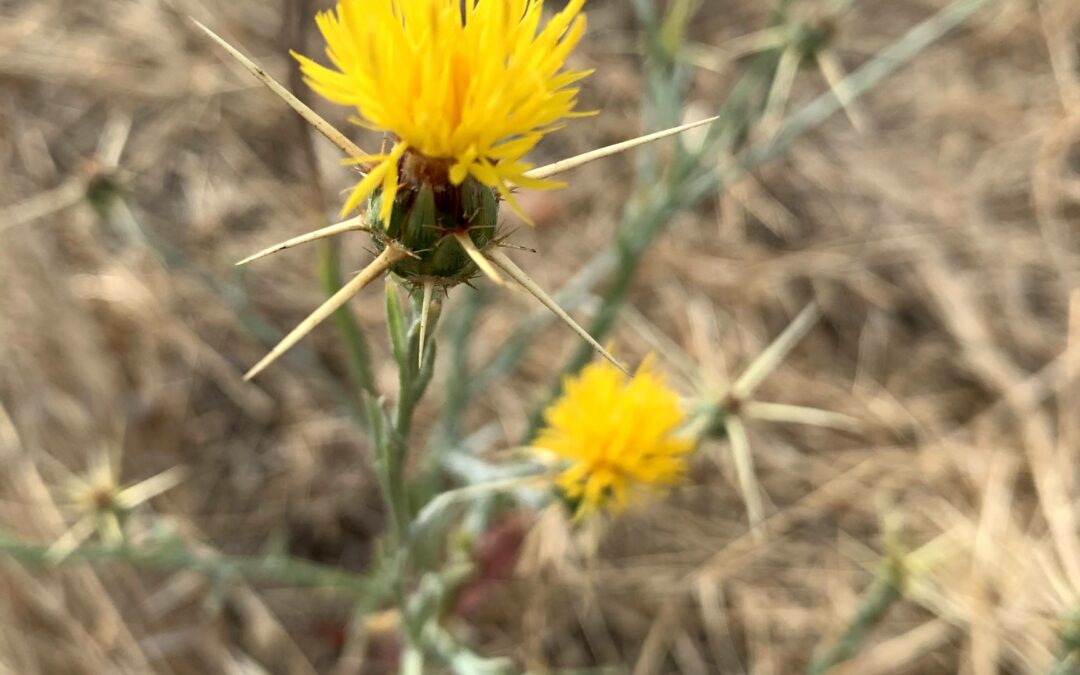Additional information:
- Overall rating for honeydew: 4/5
- Nectar: 3/3
- Pollen: 3/3
- Color: Yellow
Blooming Yellow Star Thistle in Contra Costa County California:
- June 16, 2024
- June 16, 2023
Yellow star thistle (Centaurea solstitialis) is a prominent and controversial plant in the Bay Area, known for its invasive nature and impact on local ecosystems. Despite its negative reputation, this plant holds particular significance for beekeepers due to its abundant nectar production, which is essential for honeybee health and honey production.
Yellow Star Thistle: An Overview
Yellow star thistle is an annual plant native to the Mediterranean region that has become widespread in California. It thrives in disturbed soils and can dominate grasslands, pastures, and roadside areas. Recognizable by its bright yellow flowers and spiny bracts, yellow star thistle blooms from late spring through fall, providing a long period of nectar availability.
The Role of Yellow Star Thistle in Beekeeping
While often considered a nuisance due to its invasive nature, yellow star thistle plays a significant role in the beekeeping community. Its extensive flowering period and high nectar yield make it a crucial food source for honeybees during the dry summer months.
1. Nectar Source: Yellow star thistle is one of the most prolific nectar producers in the Bay Area. The nectar from its flowers is a key ingredient in the production of star thistle honey, known for its light color and delicate flavor. This honey is highly prized by consumers and forms a significant part of the local honey market.
2. Sustaining Bee Populations: During the hot, dry summers when other nectar sources are scarce, yellow star thistle provides a reliable source of sustenance for bee colonies. This ensures the bees remain healthy and productive, which is crucial for both honey production and pollination services.Benefits to Urban Beekeeping
Urban beekeeping in the Bay Area benefits significantly from the presence of yellow star thistle. The plant’s ability to thrive in various conditions, including urban environments, ensures that bees have access to a consistent food source throughout the blooming season. Beekeepers often place hives near areas abundant with yellow star thistle to take advantage of its nectar.
Environmental and Management Considerations
Despite its benefits to beekeeping, yellow star thistle poses environmental challenges. It can outcompete native vegetation, reduce biodiversity, and degrade pasturelands. Effective management strategies are necessary to control its spread while allowing beekeepers to harness its nectar resources. Integrated management practices, such as targeted grazing, mowing, and biological control agents, can help mitigate its impact.
Conclusion
Yellow star thistle is a plant of dual nature in the Bay Area: an invasive species with ecological drawbacks but also a valuable nectar source for beekeeping. Its long blooming period and high nectar production are crucial for maintaining healthy bee populations and producing sought-after honey. With careful management, the beekeeping community can continue to benefit from this plant while minimizing its negative environmental impact. By striking a balance, beekeepers and environmentalists can work together to support both agricultural and ecological health in the region.

